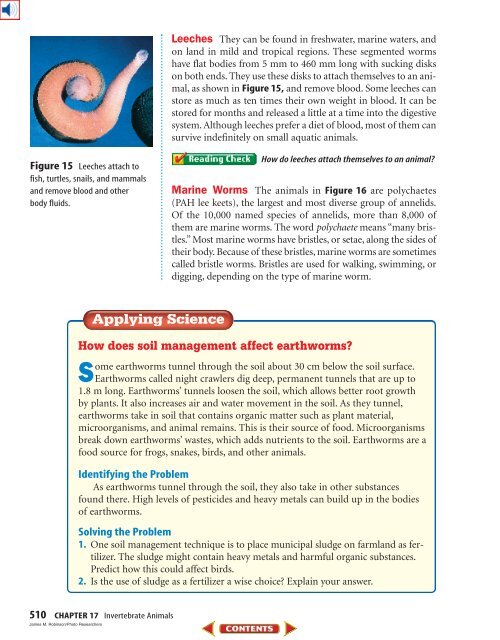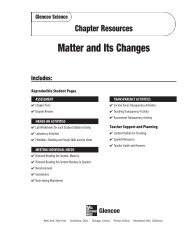Chapter 17: Invertebrate Animals
Chapter 17: Invertebrate Animals
Chapter 17: Invertebrate Animals
You also want an ePaper? Increase the reach of your titles
YUMPU automatically turns print PDFs into web optimized ePapers that Google loves.
Leeches They can be found in freshwater, marine waters, and<br />
on land in mild and tropical regions. These segmented worms<br />
have flat bodies from 5 mm to 460 mm long with sucking disks<br />
on both ends. They use these disks to attach themselves to an animal,<br />
as shown in Figure 15, and remove blood. Some leeches can<br />
store as much as ten times their own weight in blood. It can be<br />
stored for months and released a little at a time into the digestive<br />
system. Although leeches prefer a diet of blood, most of them can<br />
survive indefinitely on small aquatic animals.<br />
Figure 15 Leeches attach to<br />
fish, turtles, snails, and mammals<br />
and remove blood and other<br />
body fluids.<br />
How do leeches attach themselves to an animal<br />
Marine Worms The animals in Figure 16 are polychaetes<br />
(PAH lee keets), the largest and most diverse group of annelids.<br />
Of the 10,000 named species of annelids, more than 8,000 of<br />
them are marine worms. The word polychaete means “many bristles.”<br />
Most marine worms have bristles, or setae, along the sides of<br />
their body. Because of these bristles, marine worms are sometimes<br />
called bristle worms. Bristles are used for walking, swimming, or<br />
digging, depending on the type of marine worm.<br />
How does soil management affect earthworms<br />
Some earthworms tunnel through the soil about 30 cm below the soil surface.<br />
Earthworms called night crawlers dig deep, permanent tunnels that are up to<br />
1.8 m long. Earthworms’ tunnels loosen the soil, which allows better root growth<br />
by plants. It also increases air and water movement in the soil. As they tunnel,<br />
earthworms take in soil that contains organic matter such as plant material,<br />
microorganisms, and animal remains. This is their source of food. Microorganisms<br />
break down earthworms’ wastes, which adds nutrients to the soil. Earthworms are a<br />
food source for frogs, snakes, birds, and other animals.<br />
Identifying the Problem<br />
As earthworms tunnel through the soil, they also take in other substances<br />
found there. High levels of pesticides and heavy metals can build up in the bodies<br />
of earthworms.<br />
Solving the Problem<br />
1. One soil management technique is to place municipal sludge on farmland as fertilizer.<br />
The sludge might contain heavy metals and harmful organic substances.<br />
Predict how this could affect birds.<br />
2. Is the use of sludge as a fertilizer a wise choice Explain your answer.<br />
510 CHAPTER <strong>17</strong> <strong>Invertebrate</strong> <strong>Animals</strong><br />
James M. Robinson/Photo Researchers














